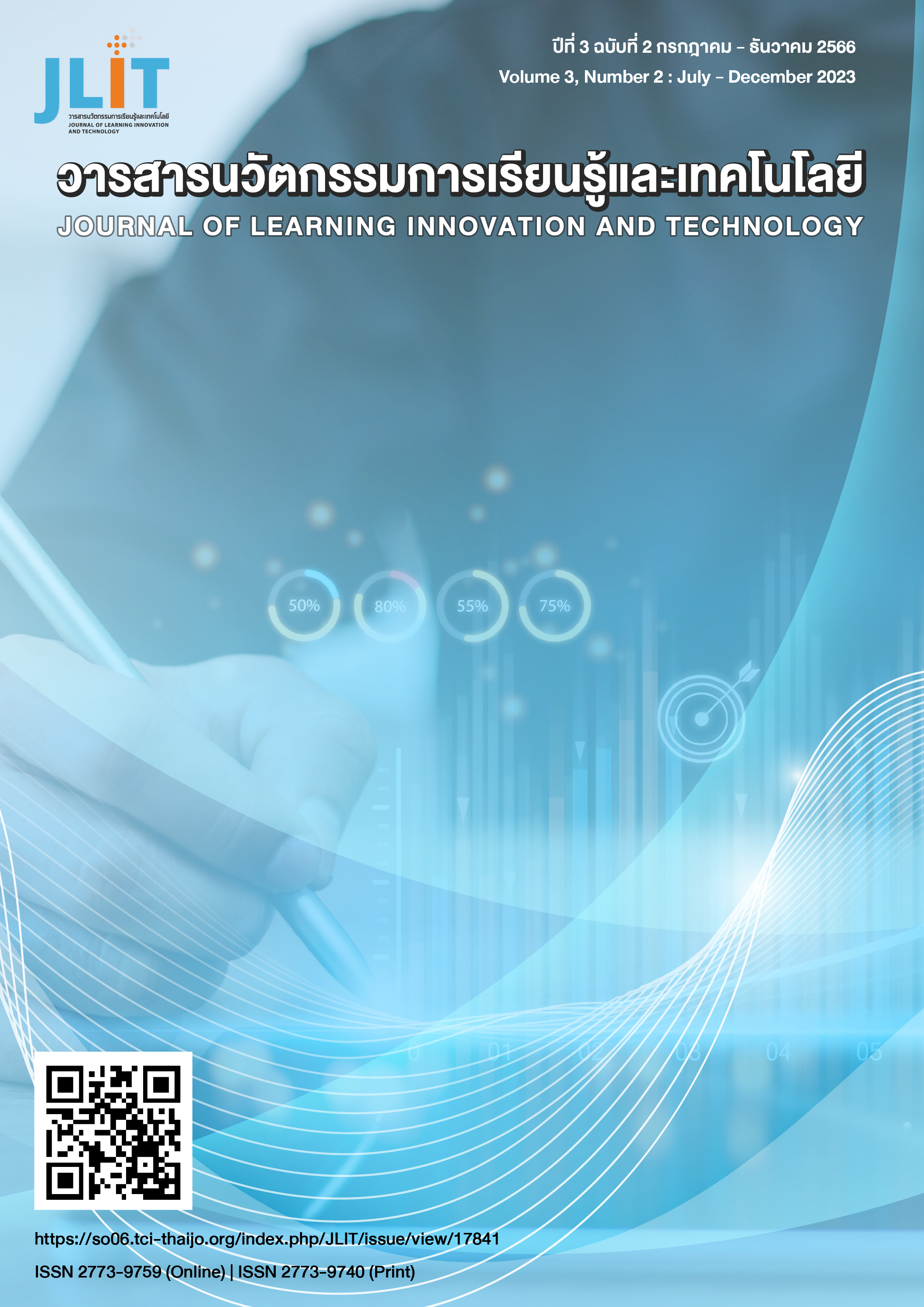การส่งเสริมความรู้ด้านผลิตภัณฑ์สินเชื่อด้วยมัลติมีเดียนาโนเลิร์นนิง สำหรับพนักงานธนาคารเพื่อการเกษตรและสหกรณ์การเกษตร
คำสำคัญ:
มัลติมีเดียนาโนเลิร์นนิง, ความรู้ด้านผลิตภัณฑ์สินเชื่อบทคัดย่อ
มัลติมีเดียนาโนเลิร์นนิง (Multimedia Nano Learning) ถือเป็นกลยุทธ์ที่กำลังได้รับความนิยมการพัฒนาบุคลากรจากองค์กรชั้นนำ เพราะเป็นลักษณะหน่วยการเรียนรู้ขนาดเล็ก ผู้เรียนง่ายต่อการเข้าถึงโดยไม่จำกัดทั้งช่วงเวลาสถานที่ งานวิจัยนี้จึงมุ่งนำกลยุทธ์ดังกล่าวมาพัฒนาสื่อมัลติมีเดียนาโนเลิร์นนิงเพื่อส่งเสริมความรู้ด้านผลิตภัณฑ์สินเชื่อของพนักงานธนาคารเพื่อการเกษตรและสหกรณ์การเกษตร พร้อมทั้งเปรียบเทียบผลการเรียนรู้ก่อนเรียนและหลังเรียนจากสื่อดังกล่าว และเปิดให้เรียนรู้อย่างอิสระผ่านบทเรียนนาโนเลิร์นนิงบนแพลตฟอร์ม Line Official Application ซึ่งเป็นไปตามลักษณะ Learn Fast, Learn Well, and Learn all the Time. ตลอดจนเก็บข้อมูลโดยใช้แบบแบบทดสอบความรู้ด้านผลิตภัณฑ์สินเชื่อก่อนเรียนและหลังเรียนด้วยแบบทดสอบคู่ขนาน ผลการวิจัย พบว่า ความรู้ด้านสินเชื่อของพนักงานหลังเรียน (X ̅=7.80, S.D. 3.66) มีคะแนนเฉลี่ยสูงขึ้นก่อนเรียน (X ̅=5.30, S.D. 1.54) อย่างมีนัยสำคัญทางสถิติที่ระดับ 0.05
เอกสารอ้างอิง
Bank for Agriculture and Agricultural Cooperatives, "BAAC Annual Report 2021," Bangkok2021, Available: www.baac.or.th.
L. Giurgiu, 2017, "Microlearning an Evolving Elearning Trend %J Scientific Bulletin," vol. 22, no. 1, pp. 18-23.
E. Alqurashi, 2017, Microlearning: A Pedagogical Approach For Technology Integration.
M. Madden and K. K. Govender, 2020, "The effectiveness of micro-learning in retail banking," South African Journal of Higher Education, vol. 34.
J. J. Dinglas, 2020, "How Does Bite-Sized Learning Work in Remote Instruction.
M. J. Dolasinski and J. Reynolds, 2020, "Microlearning: A New Learning Model," vol. 44, no. 3, pp. 551-561.
D. Chandramouli, 2021, Why Micro and Nano Learning Are the New Hot Trends in Learning. Available: https://edcircuit.com/why-micro-and-nano-learning-are-the-new-hot-trends-in-learning/
T. Kravchyna, L. Kondratska, L. Romanovska, N. Korolova, and T. Gudz, 2022, "Realization of Future Teacher’s Mental Space in the Process of Bite-Sized Learning," Postmodern Openings, vol. 13, pp. 97-117.
J. M. J. Murre and J. Dros, 2015, "Replication and Analysis of Ebbinghaus’ Forgetting Curve," PLOS ONE, vol. 10, no. 7, p. e0120644.
R. Mayer, 2009, Multimedia Learning: Second Edition.
W. Phommanee and W. Diteeyont, 2021, "Immersive Learning Enhance Cultural Intelligence: Basic Concept and Elements," ECT Journal (Education and Communication Technology Journal), vol. 16, no. 21.
R. E. Mayer, L. Fiorella, and A. Stull, 2020, "Five ways to increase the effectiveness of instructional video," Educational Technology Research and Development, vol. 68, no. 3, pp. 837-852.
M. Choy, R. Ong, M. Alliangan, and T. Lui, 2021, Designing Nano Learning™ Loops within Chatbot Conversations for Effective Learning.
L. C. Emerson and Z. Berge, 2018, "Microlearning: Knowledge management applications and competency-based training in the workplace," Knowledge Management and E-Learning, vol. 10, pp. 125-132.
M. Adam, M. Wessel, and A. Benlian, 2021, "AI-based chatbots in customer service and their effects on user compliance," Electronic Markets, vol. 31, no. 2, pp. 427-445.
K. Venusamy, N. K. Rajagopal, and M. Yousoof, 2020, "A study of Human Resources Development through Chatbots using Artificial Intelligence," in 2020 3rd International Conference on Intelligent Sustainable Systems (ICISS), pp. 94-99.
World Economic Forum, 2022, "Global Risks Report 2022: What you need to know," Available: https://www.weforum.org/agenda/2022/01/global-risks-report-climate-change-covid19.
ดาวน์โหลด
เผยแพร่แล้ว
ฉบับ
ประเภทบทความ
สัญญาอนุญาต
ลิขสิทธิ์ (c) 2023 วารสารนวัตกรรมการเรียนรู้และเทคโนโลยี

อนุญาตภายใต้เงื่อนไข Creative Commons Attribution-NonCommercial-NoDerivatives 4.0 International License.
จริยธรรมในการตีพิมพ์บทความ
- กองบรรณาธิการขอสงวนสิทธิ์พิจารณาบทความที่มีรูปแบบและคุณสมบัติที่ครบถ้วนตามข้อกำหนดเท่านั้น หากบทความนั้นไม่ตรงตามข้อกำหนด กองบรรณาธิการฯ มีสิทธิ์ในการปฏิเสธลงตีพิมพ์
- ในการขอหนังสือตอบรับการตีพิมพ์ กองบรรณาธิการฯจะออกให้ในกรณีที่บทความนั้นพร้อมที่จะลงตีพิมพ์โดยไม่มีเงื่อนไขเท่านั้น
- การพิจารณาบทความ (Peer review) ของวารสารนวัตกรรมการเรียนรู้และเทคโนโลยีถือเป็นที่สิ้นสุด ผลงานวิชาการอาจไม่ได้ลงตีพิมพ์ในเล่มที่กำหนดไว้จนกว่าจะผ่านการพิจารณาบทความ (Peer Review) และพร้อมจะลงตีพิมพ์เผยแพร่แล้วเท่านั้น
- งานวิจัยที่เกี่ยวข้องกับจริยธรรมของการวิจัยในมนุษย์และสัตว์จะต้องผ่านการประเมินโดยกรรมการจริยธรรมของต้นสังกัด
- บทความที่ส่งมาต้องไม่เคยเผยแพร่ในสิ่งพิมพ์อื่นใดมาก่อน และต้องไม่อยู่ในระหว่างการพิจารณาของวารสารอื่น บทความที่ได้รับการตีพิมพ์ถือเป็นลิขสิทธิ์ของวารสาร JLIT



